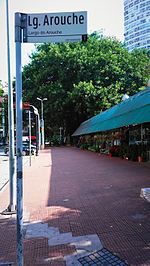The Latin America Memorial (in Portuguese, Memorial da América Latina) is a cultural, political and leisure complex, inaugurated in 1989, in São Paulo, Brazil. The architectural setting, designed by Oscar Niemeyer, is a monument to the cultural, political, social and economic integration of Latin America, spanning an area of 84,482 square meters. Its cultural project was developed by Brazilian anthropologist Darcy Ribeiro. It is a public foundation, financially and administratively autonomous, maintained by the state government.
The architectural complex consists of several buildings arranged around two squares. It comprises: Salão de Atos Tiradentes (Tiradentes "hall of acts"), the Victor Civita Latin American Library, the Brazilian Center of Latin American Studies, the Marta Traba Gallery of Latin American Art, the Pavilhão da Criatividade ("creativity pavilion"), the Símon Bolívar Auditorium, and the Latin American Parliament building. In the main square (Praça Cívica), there is a large concrete sculpture, also designed by Oscar Niemeyer, representing an open hand in vertical position, with the map of Latin America painted in red. It's a symbol of Latin America's past of oppression and its battles for freedom, with the red map as a reminder of the blood from the sacrifices that were made.The Memorial has a permanent collection of works of art, on display in indoor and outdoor areas, as well as a large assemblage of Latin American folk art, housed in the Pavilhão da Criatividade. The library comprises 30,000 titles, besides music and image departments. The Memorial promotes exhibitions, conferences, debates, video sessions, theater, dance and music performances. It also has a research center specializing in Latin American issues and keeps an active bibliographic production. From 1989 to 2007, the Memorial also served as a host to the Latin American Parliament.









